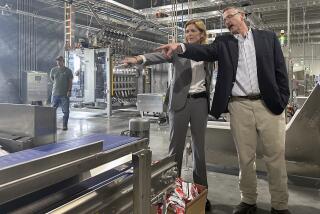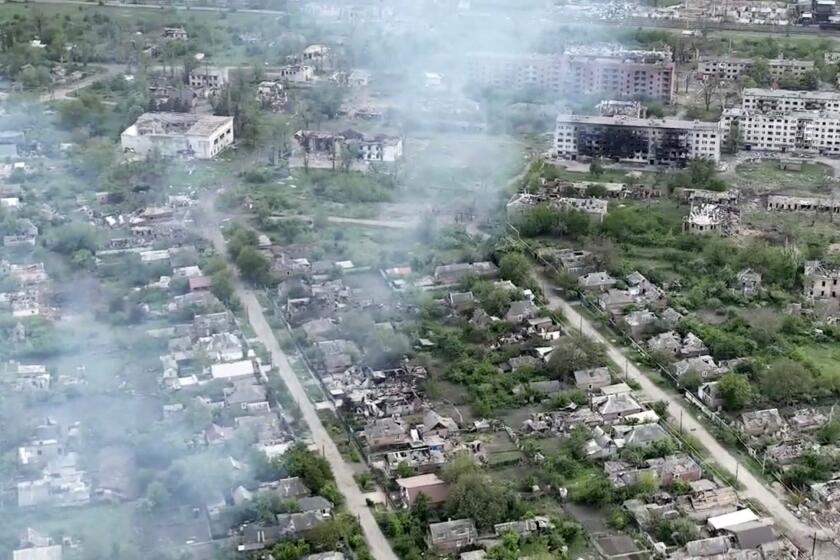2-4-6-8, This Is How We Demonstrate
These cheerleaders from Northeast Los Angeles do the splits for women’s rights, not for slam dunks. They protest with pompoms against sweatshops, and root for peace instead of points.
The chants of the Radical Teen Cheerleaders have the same cadences as those of football and basketball boosters, but with a very different message. At a recent Glendale demonstration against the U.S.-led war in Iraq, they shouted:
“Hey, Bush! / Who fights your wars? / Just minorities and the poor! / The CIA / kills people, yeah, / for corporations, yeah, they just want more! / Who trained Bin Laden? / Who armed, who armed Saddam Hussein? / We’re out, / we’re out to get, / we’re out to get those hypocrites!”
The combination of peppy cheerleading techniques and serious political protest dates back to a few efforts during the Vietnam War. Over the last few years, radical cheerleading has reemerged more forcefully across the country, with squads mainly of college students and young adults rallying for environmental, feminist, gay and other liberal causes. The war in Iraq inspired a new generation eager to make a floor-shaking statement against the Bush administration’s foreign policy -- and have some fun along the way.
The Los Angeles group, one of the few in the nation primarily made up of high school students, includes teenagers with an intensely personal stake in protesting: Some have friends and relatives in the military stationed in Iraq.
So the students, mainly from Franklin High School in Highland Park, say they are willing to withstand catcalls from some bystanders and the sneers of more orthodox cheerleaders. “We’re fighting for something. It’s not ‘Go team go!’ ” said 18-year-old Airess Depiano. “We get more pumped. We have a lot of passion for it.”
Depiano was one of 10 team members cheering in the rain in front of a Vons in Eagle Rock, supporting nearly 100 striking workers and community members picketing Saturday.
As the crowd whooped and clapped, the teens hopped and swiveled in the parking lot, reciting a cheer they made up last week: “Vons / don’t buy / Ralphs / let’s fight / Don’t cross / the line / Support workers’ rights!”
A Franklin teacher founded the group and helped recruit its 20 members, mainly Latina teenagers, but also a few boys. It operates much like a campus club, but is not formally affiliated with Franklin or the Los Angeles Unified School District.
The members have won fans with their ability to yell “Stop rape!” while balancing on each others’ shoulders. They have angered others with chants such as “SUVs waste gas!” or “No war for oil!” while performing such traditional moves as “right Ks” and “left Ls.”
“They’ve really turned the Barbie doll perception of women on its head,” said Lisa Lubow, who teaches women’s history at Glendale Community College.
She was among about 20 middle-aged activists who soberly demonstrated outside the Glendale Galleria recently against the Iraq war and occupation.
The event sprang to life with the arrival of the youthful cheerleaders, hopping in sync from side to side, clapping and yelling: “Drop Bush, drop Bush, drop Bush, not bombs!”
But not everyone has been so receptive.
Daniel Ortiz of Veterans of Foreign Wars Post 4696, a predominantly Latino group in East Los Angeles, said the antiwar cheers were offensive. “It sends the wrong message to the troops that are over there,” he said.
One of the students was forced to quit the squad by parents upset at the political chants. Another left after her mother worried that the youths might be arrested or injured during protests.
And some mainstream cheer groups are wary about what they see as a misuse of a beloved American tradition. Marc Chaykin, president of the United States Cheerleading Assn., said: “I don’t consider these to be cheerleaders, but activists using skills and techniques.”
A national website for Radical Cheerleaders credits two Florida sisters with beginning the first such squad in the mid-1990s as performance protest “with pompoms and middle fingers extended.” Another team caught attention at the World Trade Organization protests in Seattle in 1999, and more than two dozen popped up around the country.
Leone Reinbold, 26, helped start her San Francisco team mostly of twentysomethings as a way to engage people who otherwise might be turned off by “angry, unhappy” protesters.
“Everybody loves cheerleaders, right?” she said.
Meredith Ryley, 39, a history teacher at Franklin who has participated in antiwar marches, pitched the Radical Cheerleader idea last year to students who mostly considered themselves punk or goth girls after she read about a similar group in Minneapolis. The concept rapidly attracted students from different social cliques.
Ryley coordinates where students will perform and practice, and serves as the group’s motivator because, she said, she wants “kids to be empowered.”
Franklin Principal Sheridan Lietchy said she welcomes the group, allowing it to perform during school assemblies and rallies.
“We support, certainly, the freedom of speech, and I think it’s healthy for students to exercise their freedoms,” she said.
However, Larry Smith, first sergeant in charge of Franklin’s ROTC program, said he thinks the Radical Cheerleaders may be doing the bidding of adults who have a political agenda.
“This group, some of these kids could care less about the war,” he said. “Kids are just looking for their identity, and somewhere along the line they may ask themselves: ‘Why was I even involved in that?’ ”
Team members said Ryley motivates them but does not brainwash them. “This is not something you can force people to do,” said Antonette Santiago, 17, a Franklin senior in the group. “This is all our free time, on weekends, after school. If we didn’t want to do it, there’s no way she could push us.”
To join, students need simply show up for practice, which takes place in classrooms, hallways, at parks and on sports fields. Several members who used to be in mainstream cheer teams pass on the techniques to newcomers. They all work for hours to perfect moves such as the “goal post” (both hands straight in the air) and “dagger arms” (bent close to the chest).
The uniforms are dark skirts or pants and red T-shirts with a black star on the front and team name on the back. Students add their own touches: Some cut off the shirt neckline, others add funky leggings and fishnet stockings.
The team’s first performance took place about a year ago at a Hollywood rally against sweatshops. The war in Iraq upset and invigorated the group.
In November, advisor Ryley lost a close friend, Illinois Air National Guard Lt. Brian Slavenas, 30, who was one of two pilots aboard a helicopter shot down in Iraq. At the time, Slavenas’ mother, a peace activist, declared publicly that “George Bush killed my son.” After Ryley came back from the Illinois funeral, she told Slavenas’ story to her students, because she wanted them to know that “this is real,” she said. “They cried.”
Until the war began, 17-year-old Franklin High student Larry Wood had been one of the school’s regular cheerleaders, as well as on the ROTC squad, which performs military drills and marches. But as troops began shipping out to Iraq by the thousands, Wood quickly realized that his 19-year-old brother, Gustavo Lopez, a soldier, might be sent overseas too. His thoughts flooded with worries like: “What would happen if my brother died or lost a leg?”
Wood quit the school’s official cheerleading squad and ROTC, and joined Radical Teen Cheerleaders to perform “for a purpose, not some stupid game.” His brother was sent to Iraq several months later, and served a four-month stint there.
University of Alabama professor Natalie Adams, coauthor with Pamela Bettis of “Cheerleader: An American Icon,” about the history of cheerleaders, researched similar debates in the Vietnam War era.
In one case, a UC Berkeley student was elected to the school’s team and wound up leading cheers against the Vietnam War during football games. That student, Jeff Sokol, was voted off the team after sororities and fraternities complained. In another case, student Eddie Anderson was elected to UCLA’s squad in the late 1960s, Adams said. He performed a parody of the popular song “Rock Around the Clock” at a football game, singing instead: “Bomb Around the Clock,” she said.
At Franklin, Ryley said current criticism is frustrating. The students are protesting “because they love their country,” she said.
After hearing bystanders at a rally denounce her team as communists, Franklin student Santiago encountered debate at home too. Her stepfather, Felipe Contreras, tried to discourage her. But as time went on, he watched the team perform and decided “they are all good kids.” Even though he backed the war in Iraq, he also supports his daughter’s right to free speech, he said.
Lourdes Moya, a thoughtful teenager with straight black hair and black-rimmed glasses, said she was originally repulsed by the idea of cheering, even for a political cause.
But a former classmate had recently returned from military service in Afghanistan and told her about killing people, and it horrified her, she said. After watching a cheer practice, she decided that cheering was an effective protest and joined the team. “When you see the girls flying up in the air, it catches attention,” Moya said. “It’s just shock. We don’t see as much of our generation out there protesting, and I think that’s what really draws attention to us.”
More to Read
Start your day right
Sign up for Essential California for news, features and recommendations from the L.A. Times and beyond in your inbox six days a week.
You may occasionally receive promotional content from the Los Angeles Times.





